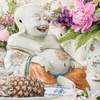TERRIN med LOCK, kompaniporslin. Qing dynastin, Qianlong (1736-95).
Modellerad i form av en sittande Budaifigur, delad i två delar, lock och underdel i brösthöjd. Den leende figuren är har bar bringa, händer och fötter i svagt rosa tonat för att imitera hud. Han är klädd i en järnröd klädnad med vit blombeströdd rock i famille rosefärger och guld hållandes en säck i vänstra handen. Höjd 38 cm.
Lagad.
Proveniens
From the Collection of Berta Berg, wife of Alfred Berg (1871-1920). Thence by descent.
Alfred Berg founded the well known asset management company today known as Alfred Berg, he amongst other thing owned Bukowski from 1905, 1906 he aquired the property at Arsenalsgatan 2, the very premises towards Berzeli Park where Bukowskis still is situated. He moved in to the floors above the Auctionhouse. He later came to own a large villa in Djursholm and the Castle Wijk near Uppsala. He was a passionate and famous art collector of that time and filled his houses with antiques and art. He married Berta Nyström in 1917 and Anders Zorn got comissioned to paint a portrait of her. Unfortunately Alfred died in 1920 from the Spanish flu. The couple hosted many extravagant dinners and parites togheter and shared eachothers interests. She inherited the estate after Alfred passing away. Berta died 1927 only 47 years old, she had a child from a previous marriage.
Litteratur
Jorge Welsh; Maria Antonia Pinto de Matos. The RA Collection of Chinese Ceramics, compare with the smaller armoiral tureen, page 277 lot 529.
Rose Kerr; Chinese porcelain in the Hallwyll museum.
Ullman, Magnus; Så levde de. Del II. Page 46-77
Övrig information
Budai is usually identified with or seen as an incarnation of Maitreya, the future Buddha, so much so that the Budai image is one of the main forms in which Maitreya is depicted in China. He is almost always shown smiling or laughing, hence his nickname in Chinese, the Laughing Buddha. He carries his few possessions in a cloth sack, being poor but content.
According to Chinese history, Budai was an eccentric Chan monk who lived in China in the 1000th Century.
Budai in folklore is admired for his happiness, plenitude, and wisdom of contentment. One belief popular in folklore maintains that rubbing his belly brings wealth, good luck, and prosperity.


















































